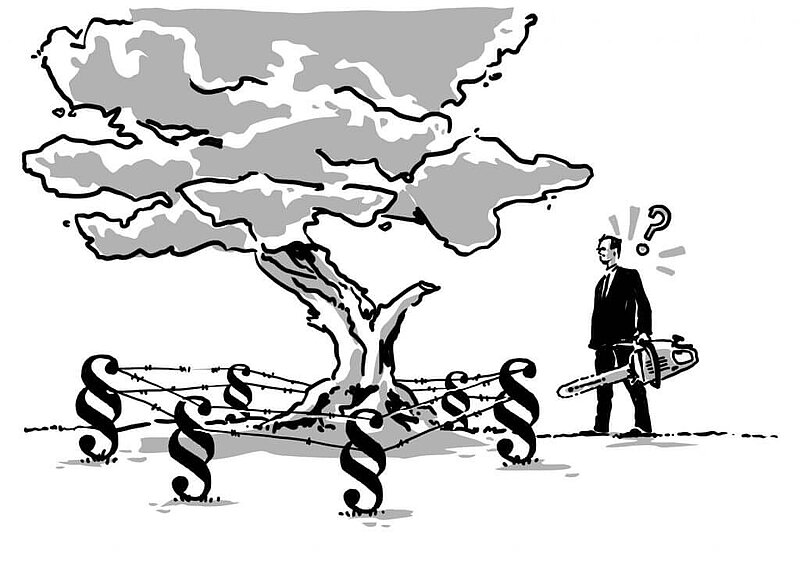
The Governance Post's Sanggeet Mithra Manirajah asks if product labelling can really curb deforestation.
Pick up a carton of organic milk in Edeka, and you will likely find a label indicating that its packaging is sourced from responsibly managed forests. Such labels are a means to ensure the protection of the world’s forests and are a key element of the international climate mitigation agenda. Around 25% of global greenhouse gas emissions originates from agriculture and land-use change in forested areas and 70% of forest loss is due to the production of agricultural commodities alone. Recognizing the central role of the private sector in addressing this, 57 multinational companies endorsed the New York Declaration on Forests in 2014, with the aim of eliminating deforestation from their supply chains of commodities such as palm oil, beef, soy, paper and wood by 2020.
These targets are extremely ambitious, but are the minimum necessary to mitigate the impact we are already observing from a 1-degree rise in global temperatures. In their efforts to achieve these pledges, companies rely on certification bodies, such as the Roundtable on Sustainable Palm Oil and the Round Table on Responsible Soy, to source raw materials with a minimal impact on forests. Yet, existing traceability models do not require companies to source 100% of commodities from certified sources to label their products as sustainable or responsible. If a chocolate company procures a quarter of its cocoa from certified sources, then a quarter of the final products can be labelled as certified, even if those particular chocolate bars do not contain even an ounce of certified cocoa.
While most deforestation takes place in the countries of the Global South, corporate pledges on zero-deforestation are driven by consumer preferences in the Global North. Many companies with zero-deforestation commitments source their raw materials through an opaque network of commodity supply chains, in which suppliers and producers are located thousands of kilometres away with complex ownership structures.
Accurately tracing the origin of raw materials is thus a challenge, in addition to the high cost of monitoring. On the ground, suppliers and producers are resistant to disclose their procurement methods and often move to other buyers that have less or no sustainability requirements. Further, when large multinationals impose strict procurement standards without investing in producers’ capacities, smallholder farmers and growers are adversely affected and removed from these supply chains, leading to food and livelihood insecurity.
There is no lack of analyses on how companies can improve the sustainability of their supply chains. Nonetheless, it must be recognised that the driver for certification is not reducing deforestation; rather, it is steered by a company’s image, its stakeholder pressures, and long-term efficiency and competitiveness. The underlying logic and motivation for certification is finding the cheapest and most efficient way for a company to make a claim about the origins of a commodity. Consequently, we end up with a system that produces specialty products that can only be afforded by the “environmentally and socially conscious” elite, perpetuating the illusion that consumption is not dependent on the destruction of the planet. If forests are being destroyed, it is because people are not buying green-labelled products. This rationale is the neoliberal dream of consuming our way out of climate change.
Certification is not only ineffective in combating deforestation, it presents a veneer that existing private-sector approaches are effective and more should be done in that direction. An overemphasis on certification blinds us to the fundamental question of whether our systems of production makes sense for people and the planet. Merely improving certification and procurement standards will not help us achieve the goals of the New York Declaration on Forests. To limit further forest loss, the priority should be around the politics and policies of forest governance structures in countries with high forest density.
Local governments around the world are already taking the lead in developing innovative policies and approaches for the sustainable management of forests across social, environmental and economic dimensions. Sustainability is measured across the jurisdiction – whether it is a province, district, or state – and involves the synergy of different activities, production systems, and actors. In this approach, the subnational government becomes the key actor in ensuring that the activities and processes linked to commodity production are done in a way that ensures the conservation of primary forests. Guaranteeing the rights of indigenous peoples and local communities in the governance of forests is an imperative ingredient to this approach – studies have shown that forestlands stewarded by indigenous and local communities have much lower rates of forest loss and increased enhancement of ecosystem services such as water flow regulation, disease control and rainfall generation.
Governance and enforcement capacities in many countries with forestlands tend to be weak due to impacts of colonial legacy and corruption, among other factors. In light of this, climate finance can address this gap by providing finance to local governments and jurisdictions to improve their forest governance structures. These finance options should be conditional upon local governments implementing the principle of free, prior and informed consent (FPIC) and guaranteeing the tenure rights of indigenous peoples and local communities. Following this, alignment between private sector companies and these jurisdictional initiatives should be developed through preferential sourcing policies, where companies would source commodities only from producers within these jurisdictions. This has the two-pronged benefit of ensuring the continuity of these jurisdictional efforts and encouraging such initiatives in other forested regions.
The gravity and urgency of climate change requires us all, whether in the private or public sector, to stop pursuing band-aid solutions that neglects the root causes of deforestation. Instead, we need to create, test and implement production and political systems that are centred on the protection of forests, while guaranteeing the dignity and livelihood of communities directly and indirectly dependent on them. Until then, that carton of milk labelled sustainable will merely be a label.
This piece originally ran in the Hertie School's student magazine, The Governance Post.
